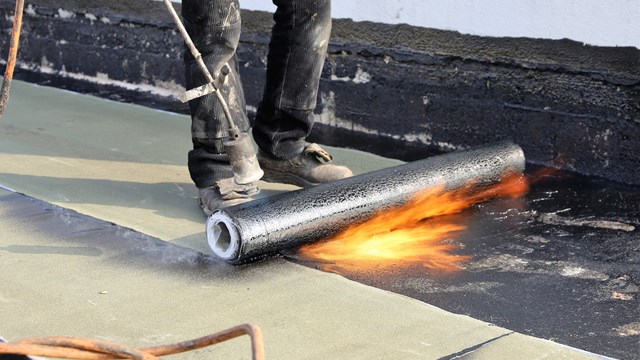Remember the old jingle, ‘it takes a licking and keeps on ticking’? It was the famous tagline from the Timex watch advertisements. The gist of the ad is that no matter what you threw at it, a Timex watch kept working.
If you think about it, a building’s exterior is almost like a Timex watch. Each year, Mother Nature throws its best curveballs—intense sun, high winds, fierce rains, heavy loads of snow and ice, and frigid temperatures—at the outside of the buildings. Don’t forget the pollution, dirt from such animals as pigeons and, of course, any items that accidentally hit the exterior. The exterior continues to stand and takes it all in. Well, almost. A building’s exterior can take a lot of abuse, but after time, it does begin to show wear and tear and needs some TLC.
The Root of All Evil (and Leaks)
It's perhaps a little ironic that source of life on Earth is the kryptonite of all modern shelter. When it comes to building exteriors, water basically ruins everything down to the steel rods that provide the skeletal support of newer buildings. One of the most commonly found issues in exterior inspections are waterproofing deficiencies, such as failed flashing systems, cracked/split sealants, peeling/cracked deck coatings and vertical coatings; masonry deficiencies such as cracked/spalled brick or stone, and missing/failed mortar joints, along with concrete deficiencies like spalling, cracking, or delamination.
“Usually they’re calling us when there’s some kind of water infiltration. Our objective is to open up the surfaces and see if we can find the point of penetration, and then see if they’re consistent with the rest of the building. Usually a general contractor will use the same subcontractor for the whole project, so the problems tend to be consistent throughout the building,” says James Rademacher, CEO of Rezkom Enterprises in Ocean.
The material of the building's exterior will determine just how water is getting in. “If you have a brick building, they require certain things in order to make them work. We all know that brick is porous. If you pour water on brick, the water will go right through it. So the brick system has to be designed to shed water. So it’s important that the brick system have an air cavity behind the brick and in front of the sheathing of the building, so that incidental water that gets through the brick can hit building paper that’s on the sheathing, and roll harmlessly down that air cavity and get out of the building through weep holes or flashings that will get the water out of the building,” says Donald Brenner, a shareholder attorney and the chairman of the construction litigation group at the law offices of Stark & Stark in Lawrenceville.
Age is More Than a Number
The age of a building is an important factor to consider when inspecting the health of its façade or exterior. Unit owners and residents in brand-new condominium buildings may feel a false sense of security that since their building is new, it will take a generation for any kind of major structural issues to appear.
“Within the past 15 years, there was a figure thrown out that 90 percent of stucco and fake stone applications weren’t installed properly. We’re seeing problems with buildings that are about 6 to 12 years old. A lot of the problems go undetected for years because they start happening inside the walls,” says Anthony Geonotti, Jr., director of sales at Apex Contractors in Trenton. “The IRC code for the installation of stucco and faux stone has been in place since 2006 and updated in 2009, where they really put it down to a science, how it really needs to be installed. We’re finding that most of these problems built in this time period, it’s because there were construction defects or oversights. Usually when we open up a wall, we find evidence of something that wasn’t done properly, or the code wasn’t followed,” he says.
Reserve Studies Are Key
Once problems arise, it’s important that associations have the funds available to fix them before they get worse. The Federal Housing Administration (FHA) requires that condominiums set aside at least 10% of their operating income towards a capital reserve account. For example, if the building or HOA's annual budget is $200,000, then the association must set aside $20,000 for its capital reserve fund in order for new buyers to qualify for FHA loans.
Just as an individual needs an emergency fund in case of a job loss or an unexpected car repair, an association needs a financial reserve to take care of such major repairs as roof leaks or other exterior issues. Interestingly, a Community Associations Institute (CAI) study in 2012 found that cash-strapped associations are trying everything to make do. To compensate for a cash shortfall, the CAI study shows 38 percent have postponed planned capital improvement projects, 35 percent have reduced landscaping services, 31 percent have reduced contributions to their reserve accounts, 23 percent have borrowed from the association’s reserve account, 16 percent have levied special assessments, 12 percent are allowing residents to perform minor tasks in the community and 6 percent have borrowed from banks and other lenders.
Property managers and other industry pros recommend that reserve studies be conducted every three to five years. Routine inspections can be done even more frequently. “Sometimes older building will hire us for site maintenance and part of that might be doing routine roof inspections every couple of years,” says Rademacher.
Professionals also caution boards and managers that building envelope studies shouldn’t be performed by in-house staff (such as a superintendent or building engineer) as there are numerous safety factors to consider. Also, unless your building engineer is indeed an engineer in the professional sense, he or she might miss or misinterpret crucial inspection points, leading to problems down the road.
Transitions
Exterior inspections are probably the most important when an association is transitioning from developer to board control. “When the transition engineer notices problems, and recommends invasive testing, it should be done. That’s the only way to know if water is damaging inside the building. You stick moisture probes into the wall, get through the brick and reach into the sheathing inside the building. If the moisture meter determines there’s an excessive amount, you know the building is getting damaged. You can also cut the building open, one foot-by-one foot cuts to look behind and see how much damage is being done,” says Brenner.
Repair projects depend on weather conditions as well. “In New Jersey, specifically, because of the type of weather we have, we just had snow and ice and now we have warmer weather, so you have the thaw effects. You get ice dams that occur at the gutter line, and they start to back up underneath the shingles and cause water infiltration in those kinds of locations. If those roof components weren’t done in accordance to the code, you’re going to have water infiltration,” says Rademacher. When those materials are exposed to freezing temperatures, moisture will never make its way out. Instead, it will freeze and expand, causing cracks and spalling that can ruin concrete and mortar work altogether.
“If it’s on the Atlantic Ocean, and subject to rain storms and wind, you probably need to check those joints more carefully and more often, especially with roofing, stucco materials, EIFS (Exterior Insulation and Finish Systems) materials. If you have a shingle roof, the manufacturer will tell you right in their warranty or specifications, how often the roof needs to be inspected. With a flat roof, the manufacturer will have specifications for an annual inspection as part of the warranty. If you don’t do it, your warranty can be voided,” says Brenner.
What’s Mandated
Unlike a lot of other types of contracted work, there are clear parameters as to what's expected in an exterior inspection, but associations are not necessarily legally bound to hold inspections. “In New Jersey there’s no law or code that says you have to do inspections. They’d be qualified as best practices. There’s also no requirement as to who you need to hire to do the inspections. When the developer’s looking to finalize transition, the association then hires to get this invasive work done, and then they come up with a dollar amount to get it fixed, and the developer and association go back and forth on it until there’s a settlement or they decide to go into litigation,” says Rademacher.
Since there's no strong building codes in New Jersey related to exteriors, it's crucial that property managers and boards stay totally compliant with manufacturer specifications in regard to installation as well as maintenance. “You need to follow the manufacturers’ installation specification inspection recommendations. If we’re talking about a stucco system, the manufacturer will tell you to inspect the joints of the building every few years, and redo all the caulk joints on the building. When building code doesn’t spell out for every substance how it’s supposed to be installed and when it’s supposed to be inspected, then by default you have to follow the manufacturer’s guidelines,” says Brenner.
Cost is always an important consideration for boards and managers, and obviously varies a lot on the type of materials in the building, the size and type of building, as well as its age. Inspections can range from $1,000 and up, depending on how many units, the presence and size of balconies, the overall size of the building, and how easy it is to access common areas. Some associations request that only a few units are inspected, along with all of the exteriors. This is better than no inspection at all, but will not be as accurate as having more units inspected.
In a tough economic climate, it is becoming more common for associations to hold off on repairs until absolutely necessary to save money. But that can lead to even bigger and exponentially more expensive problems down the line for old and new buildings alike.
Staying on top of exterior maintenance prevents a problem from going from bad to worse. In addition, a well-kept exterior sets the stage for beautiful curb appeal which actually increases the value of the association’s property.
Lisa Iannucci is a freelance writer and a frequent contributor to The New Jersey Cooperator. Editorial Assistant Tom Lisi contributed to this article.







Leave a Comment